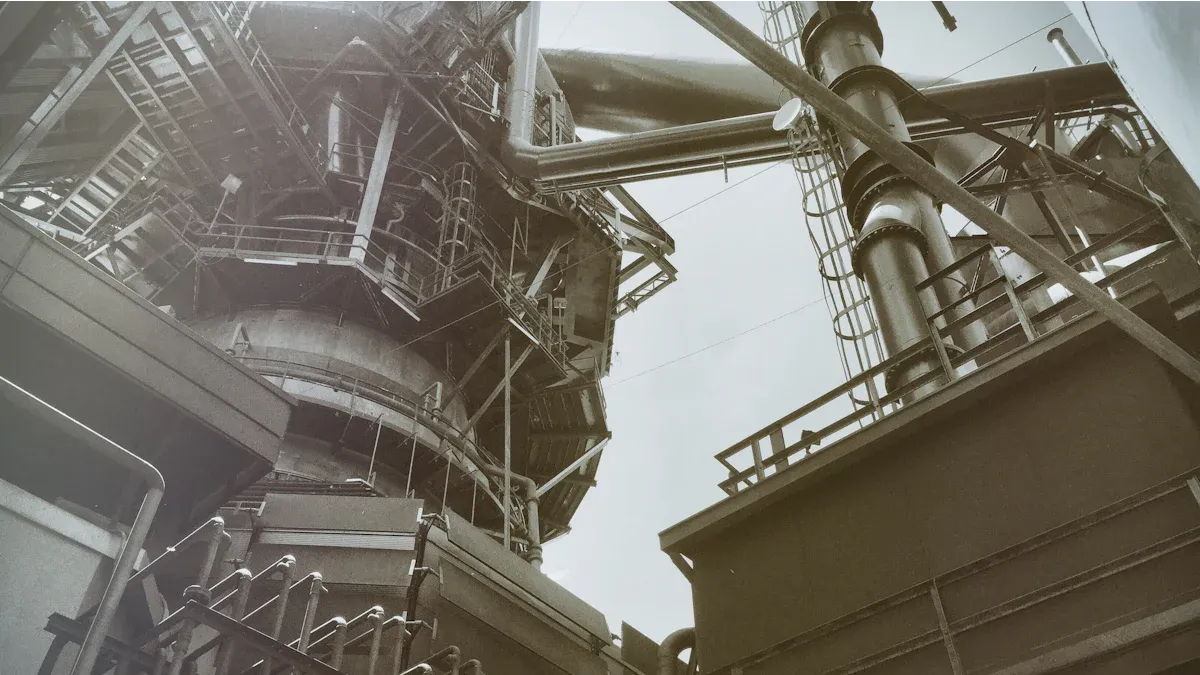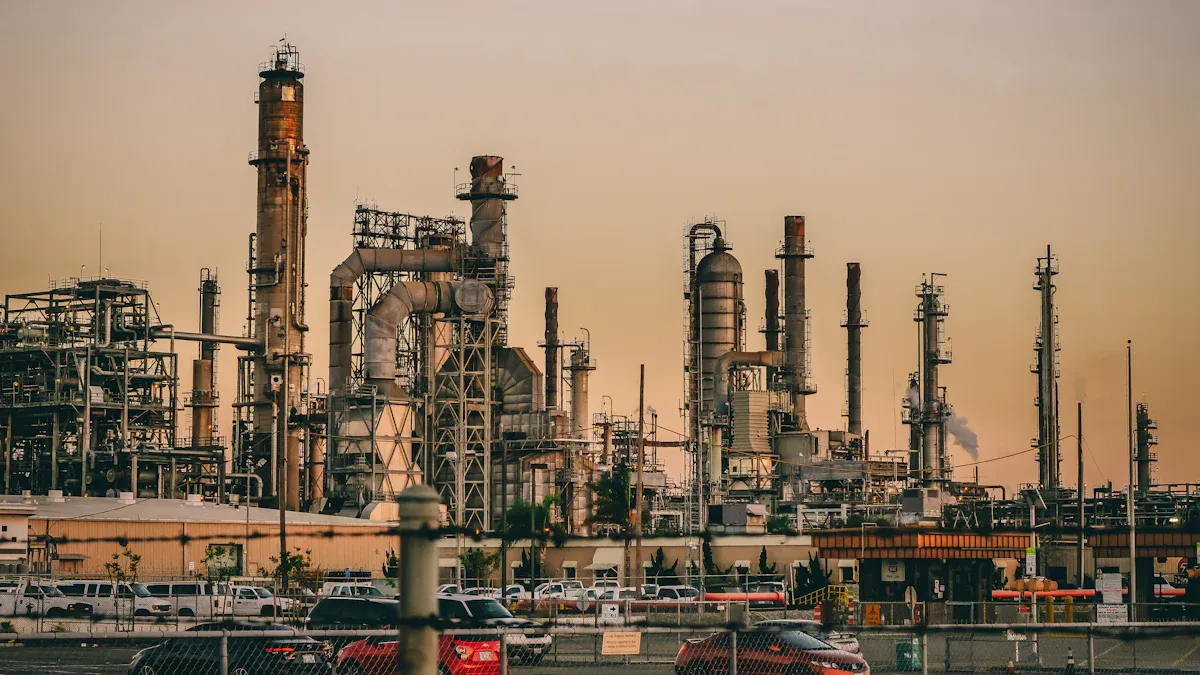Understanding Nitrogen Gas Generators and Their Functionality

Nitrogen gas generators are very important. They make nitrogen gas right where it is needed. This gas is used in many industries and businesses. It is necessary for jobs that need pure nitrogen or inert gas. In 2021, the global market for nitrogen generators was worth USD 4.2 billion. It is expected to grow to USD 5.5 billion by 2026. This shows that more people are using nitrogen generators. These systems help save money. They remove the need for large storage tanks and provide a steady supply of nitrogen.
Key Takeaways
Nitrogen gas generators give a constant supply of nitrogen. This cuts down the need for big storage tanks and saves money.
High-quality nitrogen is important for many industries. This includes food packaging and medicine to keep products safe and good.
There are two main types of nitrogen generators: PSA and Membrane Technology. Each type has its own benefits and care needs.
Using nitrogen generators can save a lot of money. They often pay back the initial costs in about 12 months.
Modern nitrogen generators have remote monitoring features. This helps with efficiency and maintenance, giving better control over nitrogen production.
How Nitrogen Gas is Made
Overview of Nitrogen Generation
You can make nitrogen gas in different ways. Each way has its own benefits and efficiency. Here are the most common methods used in industries to make nitrogen:
Method | Description |
|---|---|
Pressure Swing Adsorption | This method uses special materials to separate gases. It lets nitrogen through but keeps oxygen. |
Membrane Nitrogen Production | This technique uses a special membrane to split air into gases based on how easily they pass through. |
Fractional Distillation | This process cools air a lot and separates gases by their boiling points. It makes very pure nitrogen. |
These methods let you create nitrogen gas right where you need it. This ensures you have a steady supply for your work. The efficiency of these systems can be different, but they can make very pure nitrogen. For example, PSA nitrogen generators can make nitrogen that is 99.9995% pure. Membrane systems usually make nitrogen that is about 99.5% pure.
Importance of Nitrogen Purity
Nitrogen purity is very important for many uses. High purity nitrogen helps your processes work well. For example, in food packaging, nitrogen keeps food fresh by pushing out oxygen. In electronics, it stops oxidation during making products.
You should also think about how impurities in nitrogen can cause problems. In the pharmaceutical industry, even small amounts of oxygen can harm drug quality. So, it is important to invest in a good nitrogen generation system that makes high purity nitrogen. This helps keep your products safe and effective.
Types of Nitrogen Gas Generators

Nitrogen gas generators come in different types. Each type has special features and benefits. Knowing these types helps you pick the right system for your needs. The two most common types are PSA (Pressure Swing Adsorption) and Membrane Technology.
PSA (Pressure Swing Adsorption)
PSA technology is a popular way to make nitrogen gas. This process uses a material called Carbon Molecular Sieve. It separates nitrogen from other gases in the air. Here’s how it works:
Air Intake: The generator pulls in air from the environment.
Adsorption Process: The Carbon Molecular Sieve grabs oxygen and other gases. This lets nitrogen go through.
Pressure Release: After a while, the pressure drops. This releases the trapped gases and gets the sieve ready for the next cycle.
This method can make nitrogen that is up to 99.9995% pure. However, it needs many automated control valves. This makes maintenance harder.
Here’s a quick comparison of PSA technology and Membrane Technology:
Feature | PSA Technology | Membrane Technology |
|---|---|---|
Production Method | Uses Carbon Molecular Sieve to grab oxygen | Uses hollow fiber membranes to separate gases |
Moving Parts | Needs many automated control valves | No moving parts, uses pressure control |
Maintenance Complexity | More complex because of switching columns and valves | Easier maintenance due to fewer parts |
Gas Purity | Can be affected by water vapor in the air | Usually gives high purity nitrogen (98%) |
Equipment Footprint | Generally larger because of extra parts | Smaller and lighter installation |
Membrane Technology
Membrane Technology is another good way to create nitrogen gas. This method uses hollow fiber membranes. They separate gases based on size and how easily they pass through. Here’s how it works:
Air Separation: The generator pushes air through the membranes. Nitrogen molecules go through easier than oxygen and other gases.
Gas Collection: The nitrogen gas collects on the other side of the membrane, ready to use.
Membrane systems are known for being simple and efficient. They usually provide nitrogen with about 98% purity. Here are some key benefits of Membrane Technology:
Customizable Operation: You can change the pressure points to fit your needs.
Energy Efficiency: The system can go into standby mode when demand is low, saving energy.
Compact Design: These systems take up less space, making them great for smaller places.
Membrane Technology also starts up quickly, which reduces downtime during emergencies. With low maintenance needs, you can expect lower costs to operate.
Advantages of Nitrogen Generators
Efficiency and Cost-Effectiveness
Nitrogen generators are very efficient and save money for businesses. You can get back your initial costs quickly, often in just 12 months. The yearly costs for nitrogen generators are about one-tenth of older methods. This means a huge 90% savings.
Generators make only the nitrogen you need. This cuts down on waste and uses resources well.
You don’t have to worry about getting nitrogen cylinders delivered. This makes operations smoother and improves production.
Here’s a quick look at costs for different nitrogen production methods:
Method of Nitrogen Production | Additional Costs | ROI Timeframe | |
|---|---|---|---|
PSA Generator | < $0.15 | Low (electricity, maintenance) | < 2 years |
Liquid Nitrogen (limited supply) | Up to $1 | High (transportation, storage, venting) | N/A |
Flexibility in Production
Nitrogen generators give a steady supply of nitrogen gas whenever you need it. This is important for changing industrial needs. You don’t have to check gas levels or plan deliveries, which makes your work more efficient.
New nitrogen generators also let you monitor them from afar. This helps with maintenance and keeps nitrogen flowing without stops. You can change the flow rates and purity levels for different uses, showing how flexible these systems are.
Applications of Nitrogen Gas
Food Packaging
Nitrogen is very important in food packaging. It helps keep food fresh. Nitrogen replaces oxygen in packages, which stops spoilage. This helps snacks, meats, and dairy last longer. The food and drink industry uses about 50% of nitrogen. The market for nitrogen in this area is expected to grow over 8.3% from 2024 to 2030. By using nitrogen generators, companies can make nitrogen on-site. This ensures they have enough for their packaging needs.
Electronics Manufacturing
In electronics manufacturing, nitrogen is key for product quality. You might not know, but ultra-high purity nitrogen creates safe environments for delicate parts. For example, during semiconductor production, nitrogen purging stops damage from oxygen. This process protects tiny structures on wafers. Using nitrogen gas in this industry is crucial for high quality and reliability in electronic devices.
Chemical Processing
Nitrogen is also very useful in chemical processing. It helps create safe environments during reactions. This stops unwanted reactions with oxygen and moisture. Many chemical processes need controlled settings to ensure safety and quality. By using nitrogen generators, companies can make nitrogen gas when they need it. This cuts costs and improves efficiency. The global nitrogen market was worth USD 44.2 billion in 2023, showing its importance in many industries.
Pharmaceutical Industry
In the pharmaceutical industry, nitrogen is very important for product quality and safety. You use nitrogen in many steps, from making drugs to packaging them. Here are some main uses:
Inert Atmosphere: Nitrogen creates a safe environment when making sensitive drugs. This stops oxidation and contamination, which can harm the effectiveness of medicines.
Storage: Pharmaceuticals are often kept in containers filled with nitrogen. This keeps out moisture and oxygen, helping products last longer.
Cryopreservation: Nitrogen is key in cryopreservation. You use liquid nitrogen to freeze biological samples, like cells and tissues, for research and medical use. This keeps these samples safe for later use.
Using nitrogen generators in your facility can make things more efficient. You can create nitrogen on-site, so you don’t need big storage tanks. This saves space and cuts costs for delivery and storage.
Tip: Always check nitrogen purity levels. High purity nitrogen is crucial for keeping pharmaceutical products safe. Impurities can cause serious problems, including reduced drug effectiveness.
Nitrogen gas generators are very important in many industries. They give a steady supply of nitrogen, which is needed for many uses. By making nitrogen on-site, you can save a lot of money. Here are some main benefits:
Lower cost for each unit of nitrogen is cheaper than gas cylinders.
Great air and energy use means resources are used well.
PSA design fits small nitrogen needs, so it can adapt to your needs.
Knowing how these systems work helps you improve your processes and lower costs effectively.
FAQ
What is a nitrogen gas generator?
A nitrogen gas generator makes nitrogen gas right where you need it. It removes the need for big storage tanks. This means you get a steady supply of nitrogen for things like food packaging and making electronics.
How does PSA technology work?
PSA technology uses a special material called Carbon Molecular Sieve. This sieve separates nitrogen from other gases in the air. It traps oxygen and other unwanted gases, letting pure nitrogen pass through for different uses.
What are the benefits of using nitrogen generators?
Nitrogen generators save money, work efficiently, and are flexible. They help you depend less on outside gas suppliers. They also lower your costs and give you a steady supply of nitrogen that fits your needs.
How pure is the nitrogen produced by these generators?
The purity of nitrogen depends on the technology used. PSA generators can make nitrogen that is 99.9995% pure. Membrane systems usually produce nitrogen with about 98% purity. High purity is very important for many industrial uses.
Can I monitor nitrogen generators remotely?
Yes, many new nitrogen generators have remote monitoring features. This lets you check how they are working, change settings, and make sure you have a steady nitrogen supply without being there in person.
